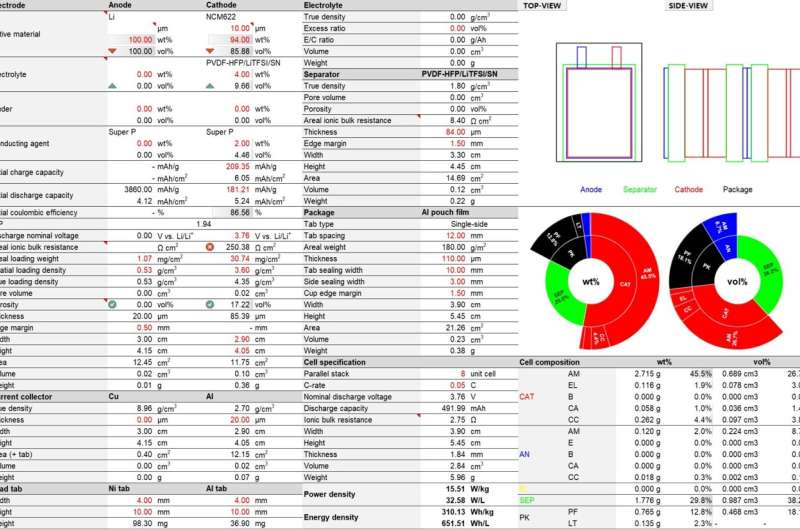This article has been reviewed according to Science X's editorial process and policies. Editors have highlighted the following attributes while ensuring the content's credibility:
fact-checked
peer-reviewed publication
trusted source
proofread
Korean team presents universal design principles for solid-state batteries

A Korean research team has presented the first universal design principles for solid-state batteries, signaling a paradigm shift in battery design research that previously lacked standard benchmarks.
Dr. Jinsoo Kim from the Ulsan Advanced Energy Technology R&D Center of the Korea Institute of Energy Research (KIER) and Professor Sung-Kyun Jung's research team from the Ulsan National Institute of Science and Technology (UNIST) have jointly developed a design principles and a versatile design toolkit for implementing high-energy-density solid-state batteries and have completed performance verification.
The paper is published in the journal Nature Communications.
With the global increase in demand for electrification, an era where everything is powered by batteries is approaching. In response, the Korean government has announced the "National Strategy for Strengthening the Competitiveness of Battery Industry" to support the focused development of national solid-state battery technology.
Solid-state batteries use non-flammable solid electrolytes instead of the flammable liquid electrolytes found in lithium-ion batteries, making them safer and less prone to fire. Additionally, they offer the advantage of significantly increasing energy density through efficient cell and system structural design.
Until recently, basic research on solid-state batteries has been conducted, yielding numerous laboratory-level results. However, the lack of scientific guidelines for designing practical electrodes and cells has led to inefficient development, as it primarily relies on the experience of researchers to combine materials and control design parameters.
To address this issue, the research team defined the quantitative design parameters of the battery as the balance threshold, percolation threshold, and loading threshold. This led to the presentation of the first universal principles for designing solid-state batteries. The pouch cell produced based on these principles demonstrated an energy density of 310Wh/kg, surpassing that of commercial lithium batteries, and obtained third-party certification.
Solid-state batteries are composed of composite cathode, anode, and solid electrolyte. The energy density increases with the density of the active materials in the cathode. Based on the "cubic closed packing" structure, where spherical particles are arranged at maximum density, the research team defined the standard ratio of solid electrolyte filling the spaces between particles as the "balance threshold."
At this balance threshold, the volume ratio of active material is 74%, and the solid electrolyte is 26%. By adjusting the ratio based on this value, design strategies can be determined between energy density and power density.
The minimum condition for lithium ion conduction in the composite cathode was also established. The research team defined the minimum density at which composite particles of active materials and solid electrolytes are in contact with each other as the "percolation threshold."
Under this condition, the space between composite particles must be 26% or less. If the space exceeds this percentage, the particles will not be in contact, preventing ionic flow and causing the battery to fail to operate.
Additionally, the research team devised a method to design the thickness of the electrode by calculating the specific conditions under which voltage drop occurs within the cathode. The thickness of the electrode is determined by voltage drop due to resistance and current density.
The team defined the ideal model as the combination of conditions where the voltage drop is within 100mV (millivolts), calling this the "loading threshold." This condition can be used as a guideline to optimize the thickness of the electrode plates when combining various materials and designing electrodes.
The research team successfully applied the devised design principles to build a pouch cell with a capacity of 0.5Ah and a high-energy-density of 310Wh/kg. The produced cell received official test certification from the Korea Conformity Laboratories (KCL), demonstrating the consistency of their design principles.
The research team also developed the solid-state battery design toolkit "SolidXCell," applying the design principles which is open to the public. "SolidXCell" is a multi-scale and multi-parameter design platform that allows the intuitive and systematic design of complex solid-state batteries. It is being provided free of charge to researchers for use in solid-state battery design.
Dr. Jinsoo Kim from KIER and Professor Sung-Kyun Jung from UNIST, who led the joint research, stated, "Presenting the first universal design principles for solid-state batteries with developing and sharing a design toolkit will greatly benefit the field of solid-state battery design. We hope that many researchers can use these principles to design solid-state batteries efficiently, promote significant performance improvements, and overcome the current technological barriers."
The joint research team is currently establishing the "Advanced Battery Engineering Foundry (ABEF)" the first of its kind in the Republic of Korea, with support from the Korea Institute for Advancement of Technology and Ulsan Metropolitan City. This center will provide infrastructure for manufacturing, evaluating, and analyzing prototypes of all-solid-state batteries, lithium metal batteries, and lithium-sulfur batteries for related companies in the future.
More information: Wonmi Lee et al, Advanced parametrization for the production of high-energy solid-state lithium pouch cells containing polymer electrolytes, Nature Communications (2024). DOI: 10.1038/s41467-024-50075-9
















